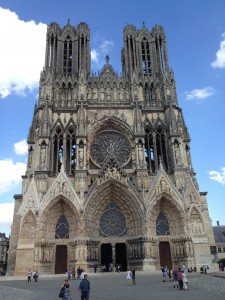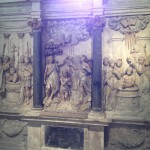
This was a day when everything went right.
It started with a walk down a narrow road from our hotel through the vineyards to the small village of Champillon for a champagne tasting at Bertrand Devanvry vineyard.
We tasted f three of their champagnes and toured their facilities, and it was all gratis, something nearly impossible to find in Napa or Sonoma these days.
We then took a Taxi to pick up our rental car, which by chance was located just 50 yards from the Mars Gate, the one sight I thought we would not see because it was not near Reims Cathedral and the The Abbey of Saint Remi, our two main sites for the day.
The exterior of Reims Cathedral is the most magnificent I’ve ever seen. For pure beauty, I rank its exterior above others I’ve seen in person, including Notre Dame in Paris, Chartres Cathedral, Saint Peter’s Basilica in Rome, Saint Paul’s in London, Hagia Sophia in Istanbul, and the Church of the Holy Sepulchre in Jerusalem.
Pictures do not do justice to the beauty of the structure. As I asked on Twitter yesterday, does this really look like something produced by a dark ages?
A church was originally built on this site around 400 A.D., where Roman baths had once been located. Reims Cathedral was rebuilt during the Carolingian Renaissance and again in the 12th century. Pope Urban II, who preached the First Crusade, was archdeacon at Reims Cathedral before he became Pope.

Next we visited the Abbey of Saint Remi. Built originally in the 6th century, it has housed the relics of Saint Remi since 1099. Remi is the bishop who in 496 A.D., baptized Clovis, the first Christian king of France (the Franks at that time).
Before he was a Christian, Clovis was a pagan and enemy of the Church. He and his army ransacked churches, stole from them and burned them to the ground. Clovis’s wife, Clotilde, a Christian, preached to Clovis for years, but Clovis did not repent.
Finally, in 496 A.D. Clovis, after the Lord responded to his battle field prayer in a miraculous, Clovis gave his life to Jesus. Clovis then preached to his army and 3,000 of his men were converted and baptized along with him the same day.
We often talk in the Church today about how change comes from the bottom up, but the conversion of Clovis–and Constantine before him–are examples of how change can come from the top down as well. I mention leadership often on this blog because leadership is essential to the progress of the kingdom of God. In my generation, the Church has been very good at reaching the poor and the homeless but not so good at reaching leaders.

With the conversion of Clovis, the destiny of France was forever changed. Without Clovis one wonders whether there would have been a Charlemagne, or a Carolingian Renaissance or empire. A marble relief in the the Abbey of Saint Remi depicting the baptism of Jesus, Constantine and Clovis gives some hint to the importance of the conversion of Clovis (see picture).
This would have been a full day, but by chance in trying to find a place to eat dinner, we wandered into the small village of Hautvilliers, where Dom Perignon served as a monk. Since we were there we decided to look inside the church for his tomb, which we had heard was there.
At first we thought the church was closed, but Cindy found an open door. Once inside she saw a reliquary with relics from Helena, mother of Constantine. This satisfied Ann’s love of the macabre and mine and Cindy’s of history. Constantine was the first Christian emperor of the Roman Empire and one of the most important figures in the history of Christianity. The story of how part of Helena ended up in this small out-of-the way church is remarkable and can be found here.
All in all it was a stellar day. GS
